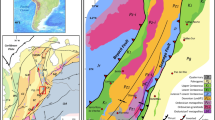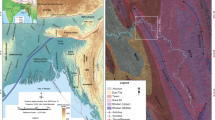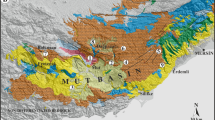Abstract
The post-glacial history of the Great Lakes has involved changes in lake levels that are equivalent in vertical extent to the Pleistocene changes in global sea level and changes in sediment accumulation by at least two orders of magnitude. In the sediments of the northern Lake Michigan basin, these radical changes in base level and sediment supply are preserved in detailed records of changing depositional environment and the impact of these changes on depositional architecture. The seismic sequences of the sediment fill previously described in Lake Huron have been carried into northern Lake Michigan and used to map the history and architecture of basinal deposition. As the Laurentide Ice Sheet retreated northward in the early Holocene, it opened progressively deeper channels to the east that allowed the larger lakes to drain through the North Channel, Huron, and Georgian Bay basins. At the end of the Main Algonquin highstand, about 10,200 (radiocarbon) yrs ago, the eastern drainage passage deepened in a series of steps that defined four seismic sequences and lowered lake levels by over 100 m. Near the same time a new source of sediment and meltwaters poured across the Upper Peninsula of Michigan and into the northern Lake Michigan basin from the Superior basin ice lobe. A marked increase in deposition is seen first in the northern part of the study area, and slightly later in the Whitefish Fan area at the southern end of the study area. Accumulation rates in the area gradually decreased even as lake levels continued to fall. Drainage directly from the Superior basin ended before the beginning of the main Mattawa phase about 9,200 (radiocarbon) yrs ago.
Although individual lowstand systems tracts are at the most a few hundred yrs in duration, their geometries and seismic character are comparable to marine systems tracts associated with sea level falls of similar magnitudes. In some of the thicker lowstand deposits a second order cyclicity in sedimentation can be detected in the high resolution seismic records.
Similar content being viewed by others
References
Colman, S. M., G. A. Jones, R. M. Foster & D. S. Foster, 1990. Holocene paleoclimatic evidence and sedimentation rates from a core in southwestern Lake Michigan. J. Paleololim. 4: 269–284.
Colman, S. M. & R. M. Foster, 1994. A sediment budget for southern Lake Michigan: source and sink models for different time intervals. J. Great Lakes Res. 20(1): 73–92.
Dobson, D. M., T. C. Moore & D. K. Rea, 1995. The sedimentation history of Lake Huron and Georgian Bay: results from analysis of seismic reflection profiles. J. Paleolim. 13: 231–249.
Eschman, D. F. & P. F. Karrow, 1985. Huron basin glacial lakes: a review. In P. F. Karrow & P. E. Calkin (eds), Quaternary Evolution of the Great Lakes. Geolog. Assoc. Canada Paper 66–48, 32 pp.
Godsey, H. S., T. C. Moore & D. K. Rea, 1999. Annual and seasonal late-Younger Dryas climatic variability recorded in Lake Huron varved sediments. Can. J. Earth Sci. (in press).
Goodwin P. W. & E. J. Anderson, 1985. Punctuated aggradational cycles; a general hypothesis of episodic stratigraphic accumulation. J. Geol. 93(5): 515–533.
Holocombe, T. L., D. F. Reid, W. T. Virden, T. C. Johnson, R. de la Sierra & D. L. Divins, 1996. Bathymetry of Lake Michigan. World Data Center A for Marine Geology and Geophysics Report MGG11.
Hough, J. E., 1955. Lake Chippewa, a low stage of Lake Michigan identified by bottom sediments. Geol. Soc. Am. Bull. 66: 957–968.
Hughes, J., 1989. When Green Bay was a valley: the Au Train-Whitefish-Green Bay spillway. In J.C. Palmquist (ed) Wisconsin's Door Peninsula. Perin Press, Appleton Wisc., pp. 49–65.
Larson, C. E., 1985. Lake level, uplift, and outlet incision, the Nipissing and Algoma Great Lakes. In P. F. Karrow and P. E. Calken (eds). Quaternary evolution of the Great Lakes. Geol. Assoc. Can. (special paper) 30: 110–123.
Lewis, C. F. M. & T. W. Anderson, 1989. Oscillation of lake levels and cool phases of the Laurentian Great Lakes caused by inflows from glacial Lake Agassiz and Barlow Ojibway. J. Paleolim. 2: 99–146.
Lewis, C. F. M., T. C. Moore, D. K. Rea, D. L. Dettman, A. M. Smith & L. A. Mayer, 1994. Lakes of the Huron basin: Their record of runoff from the southern Laurentide ice sheet. Quat. Sci. Rev. 13: 891–922.
Moore, T. C., D. K. Rea, L. A. Mayer, C. F. M Lewis & D. M. Dobson, 1994. Seismic stratigraphy of Lake Huron-Georgian Bay And post-glacial lake level history. Can. J. Earth Sci. 31: 1586–1605.
Moore, T. C., D. K. Rea & H. Godsey, 1998. Regional variation in radiocarbon ages and the hard-water effects in Lakes Michigan and Huron. J. Paleolim. (in press).
Rea, D. K., R. A. Bourbonniere & P. A. Myers, 1980. Southern Lake Michigan sediments: Changes in accumulating rate, mineralogy and organic content. J. Great Lakes Res. 6: 321 B 330.
Rea, D. K., T. C. Moore, C. F. M. Lewis, L. A. Mayer, D. L. Dettman, A. J. Smith & D. M. Dobson, 1994a. Stratigraphy and paleolimnology record of early Holocene sediments in northern Lake Huron and Georgian Bay. Can. J. Earth Sci. 31: 1606 B 1617.
Rea, D. K., T. C. Moore, T. W. Anderson, C. F. M. Lewis, D. M. Dobson, D. L. Dettman, A. J. Smith & L. A. Mayer, 1994b. Great Lakes paleohydrology: complex interplay of meltwater, lake levels, and sill depths. Geology 22: 1059–1062.
Stanley, G. M., 1938. The submerged valley through Mackinac Straits. J. Geol. 46: 966–974.
Stuiver, M. & P. J. Reimer, 1993. Extended 14C data base and revised CALIB 3.0 14C age calibration program. Radiocarbon 35(1): 215–230.
Teller, J. T., 1990. Volume and routing of late glacial runoff from the southern Laurentide Ice sheet. Quat. Res. 34: 12 B 23.
Vail, P. R., R. C. M. Mitchum, R. G. Todd, et al., 1977. Seismic stratigraphy and global Changes in sea level. In C. E. Payton (eds), seismic stratigraphy-applications to hydrocarbon exploration. Am. Assoc. Petrol. Geol. Mem. 26: 49 B 212.
Van Wagoner, J. C., H. W. Posamentier, R. M. Mitchum, P. R. Vail, J. F. Sarg, T. S. Loutit & J. Hardenbol, 1988. An overview of the fundamentals of sequence stratigraphy and key definitions. In Sea-Level Changes: An Integrated Approach. In C. K. Wilgus, B. S. Hastings, C. G. St. C. Kendall, H. W. Posamentier, C. A. Ross & J. C. Van Wagoner (eds). Spec. Pub. Econ. Paleontol. Mineral. Tulsa 42: 39–45.
Van Wagoner, J. C., R. M. Mitchum, K. M. Campion & V. D. Ramanian, 1990. Siliciclastic Sequence Stratigraphy in Well Logs, Cores and Outcrop: Concepts for High Resolution Correlation of Time and Facies. Am. Assoc. Petroleum Geol. Meth. Explor. Series Tulsa 7, 55 pp.
Rights and permissions
About this article
Cite this article
Moore, T. The history and architecture of lacustrine depositional systems in the northern Lake Michigan basin. Journal of Paleolimnology 22, 475–496 (1999). https://doi.org/10.1023/A:1008044425303
Issue Date:
DOI: https://doi.org/10.1023/A:1008044425303




